
Belize Spice Farm
By now we had driven more than 700 miles in a country that is only 170 miles from tip to toe. And, we still had much more ground to cover.
From Hopkins we aimed south towards Punta Gorda, a Garifuna village on Belize's southern coast. I was hoping to connect with a guide there for a jungle boat tour on the Temash river through the remote and wild Sarstoon-Temash National Park.
I wasn't sure if we would be able to visit that rarely-explored corner of Belize, but it was worth a try. If that didn't work out, I wasn't too worried--Southern Belize has many other eco-tourist opportunities, and although we didn't have any other specific plans, I knew we could figure it out on the fly. Belize just seems to work that way.
South of the turnoff to Placencia on our way to Big Falls, we saw signs for something called the "Belize Spice Farm and Botanical Garden." Intrigued, we made our first diversion and pulled in for a look.
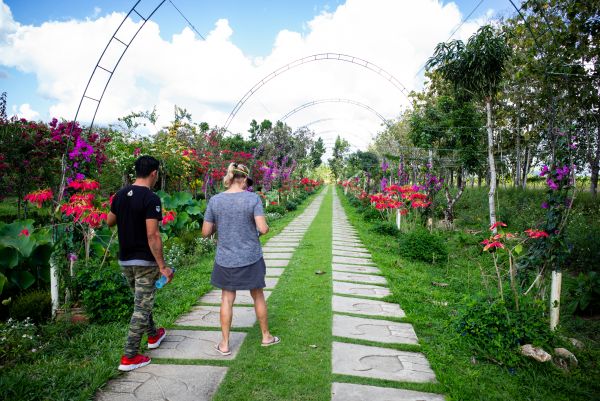
Started as a cacao and citrus farm, the Belize Spice Farm is owned by an American doctor and his wife, who came to Belize in 1989 and fell in love with the country. In establishing the farm, they sought to recreate the essence of their childhood experience growing up in Karala, India, an area known for cultivation of aromatic spices.
With over four hundred acres, in addition to citrus, the Spice Farm now grows a full palate of spices, from cardamom, cinnamon, black and green pepper, to cloves, nutmeg and vanilla. Flowering plants such as ornamental ginger, bougainvillea, and various species of Heliconia (lobster claw plant) add vibrant color to the visitor's experience.
To properly tour the farm you need to hire one of their expert guides, who will walk you around the property identifying and explaining the purposes of the various plants.
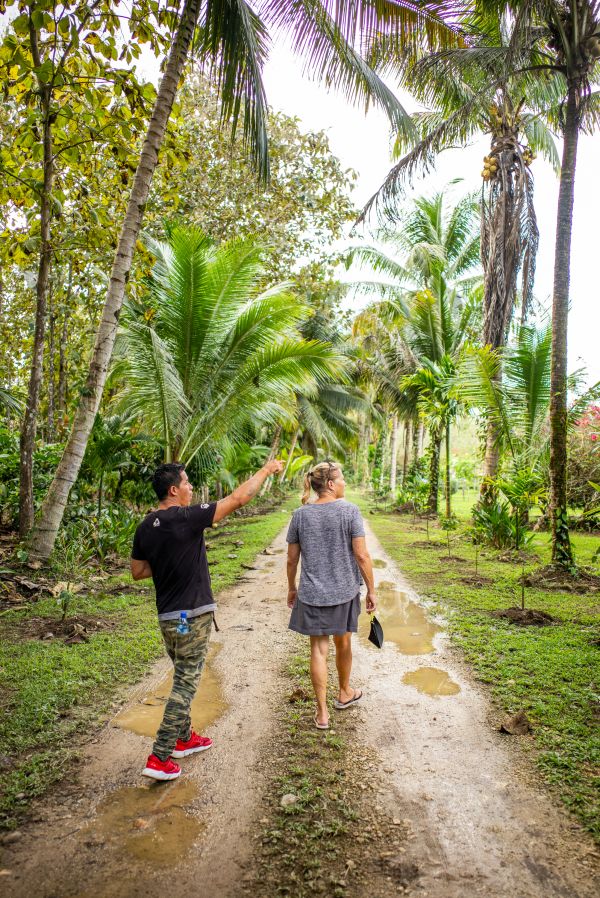
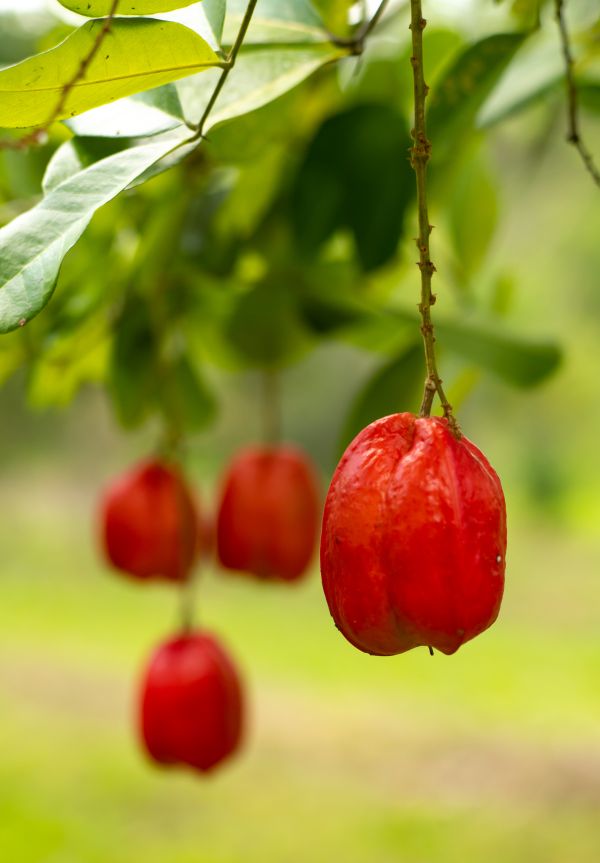
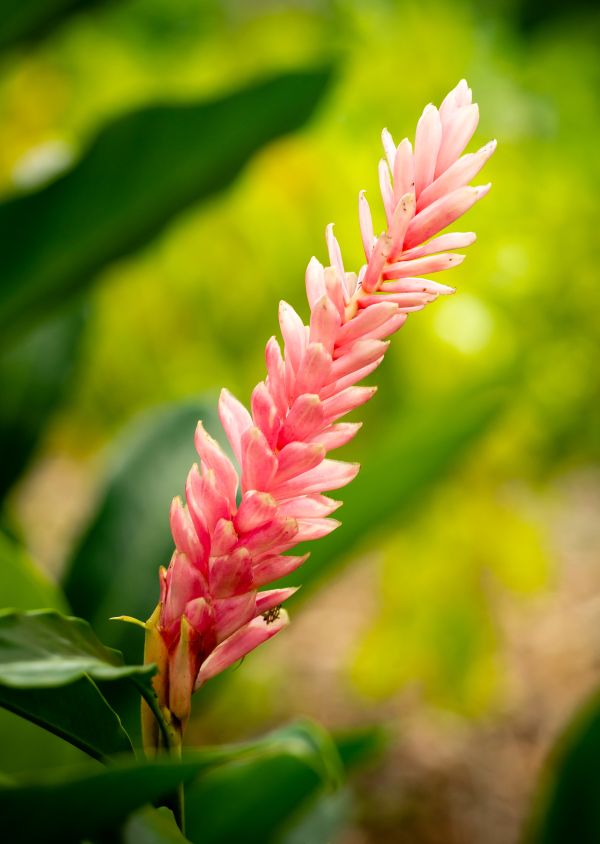
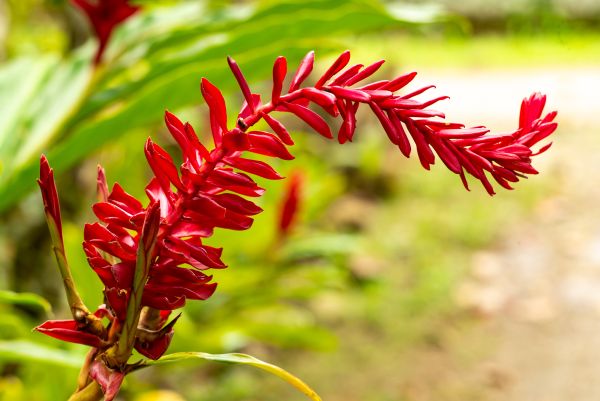
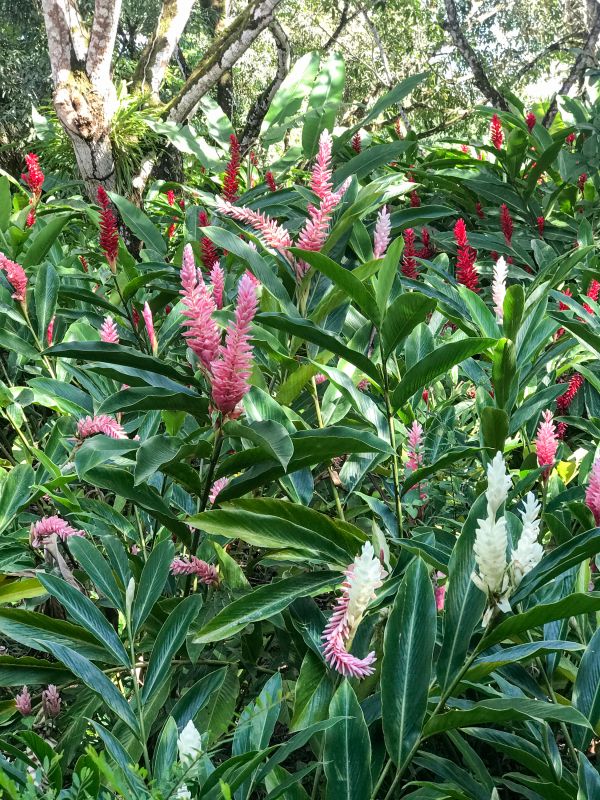
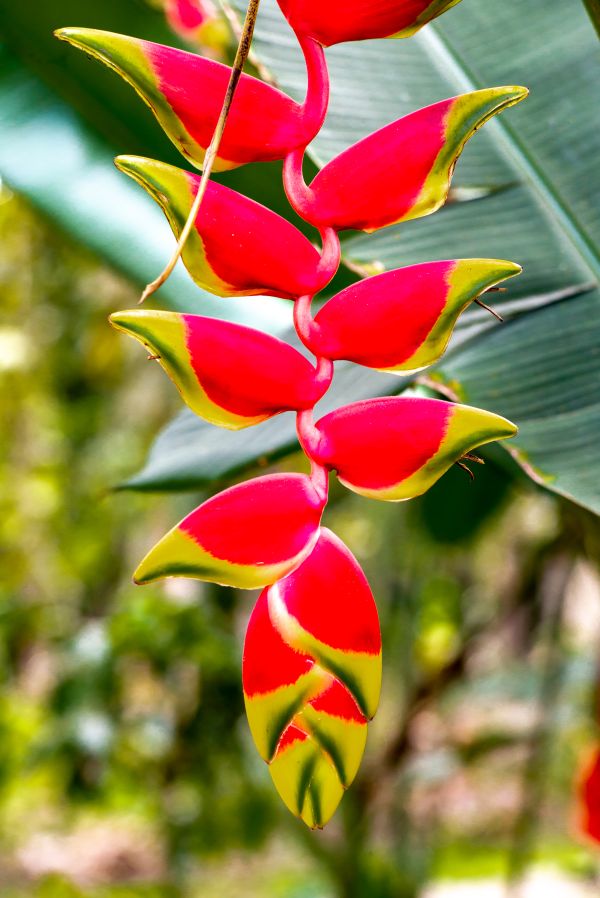
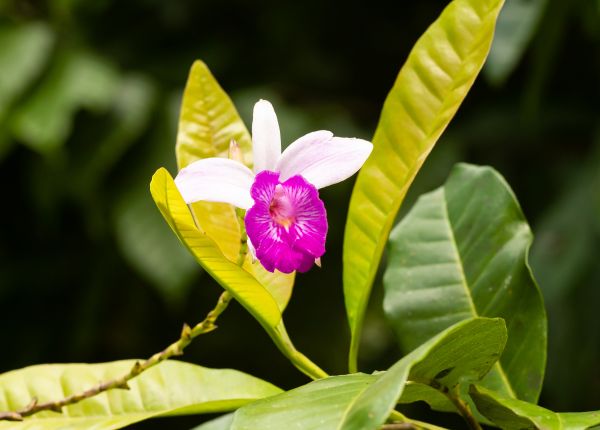
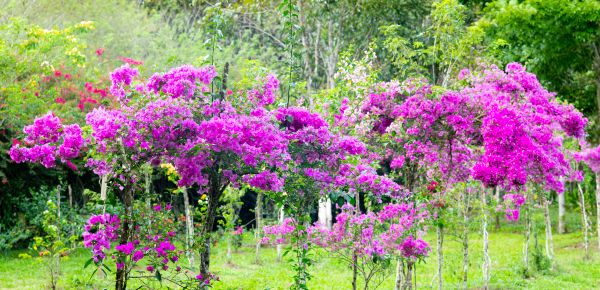
The farm's vanilla production operation was particularly interesting. The plants are hermaphroditic (flowers contain both male and female organs), and cannot easily self-pollinate. The tedious and time-consuming manual process requires using tiny toothpicks to transfer pollen from anther to stigma.
Vanilla blossoms survive for only 12 hours before they wilt and die, and if they're not properly pollinated, the prized vanilla bean will not grow. With several thousand plants to pollinate, the labor-intensive process has to be quick and precise. No wonder vanilla extract is so expensive!
The guide also showed us the cacao pod, and explained how the seeds are removed of their sticky exterior pulp before being roasted, ground, and made into chocolate.
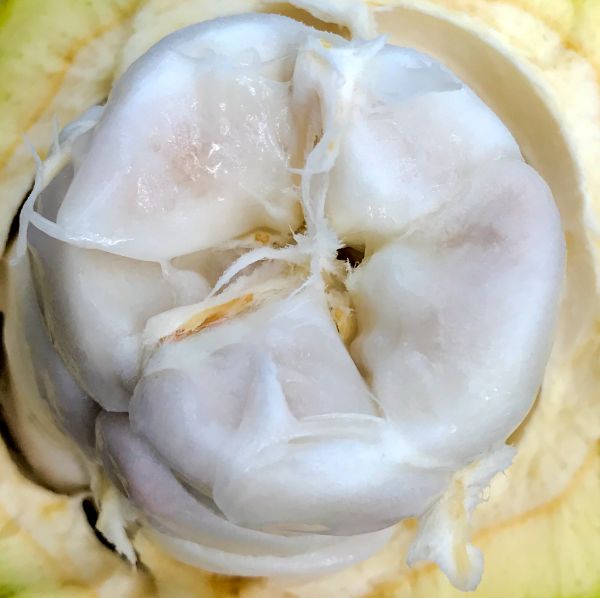
The guide opened one of the pods for our benefit, and had us sample the sweet pulp. It was surprisingly tasty, and had the definite flavor of the final product, but much lighter and much more subtle. Yum!
End of the Road
From the Belize Spice Farm we continued south, stopping for the night at our next accommodation, a cabana-type hotel called Sun Creek Lodge.
Owned and operated by a charming German couple and their two children, the lodge had a beautiful common room. I would say it was built in the "Mayan Style" (it had the requisite palm thatch roof), but not many Mayans have homes with a thick, mahogany plank floors, tables, and chairs.
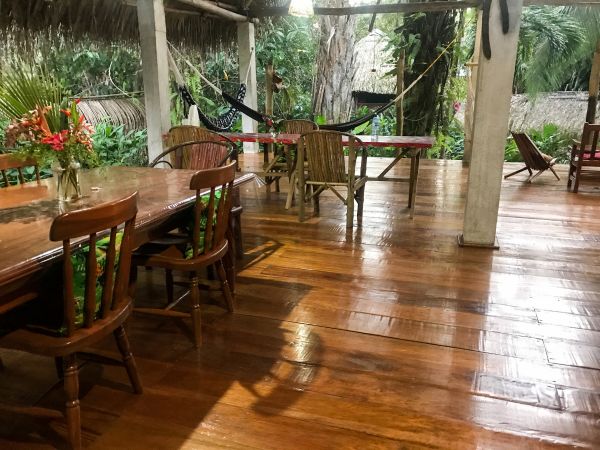
We're always intrigued by the stories of the ex-pats we see as we travel the hidden corners of the worlds. What brought them to this neck of the woods/desert/mountains/jungle? Do they miss "home", wherever that might be? And more interestingly, could we see ourselves doing something similar some day?
The answers of course vary from place to place and from person to person. I often dream of an "idyllic" farm in some beautiful spot, and it is exciting to see how some folks have answered the call. I expect, of course, that foreign living has its pluses and minuses ("Living in an exotic place is in the end, just living," a friend of ours once said), and while we can't pretend to understand the complete impact such an adventure has on a person, it has to be a life-changing experience. No doubt the owners of Sun Creek Lodge would agree.
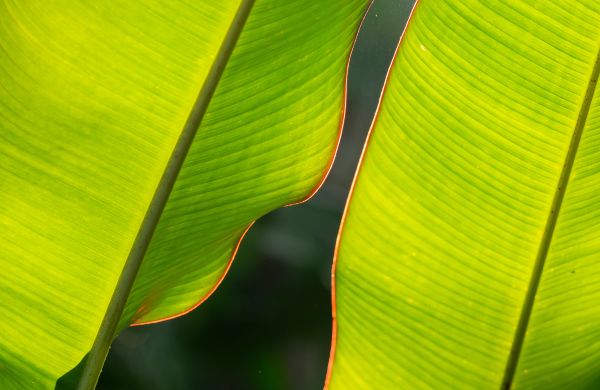
The next day we drove to Punta Gorda. A sun-weathered, beaten-down version of Hopkins, Punta Gorda marks the end of the Southern Highway. With only a couple isolated villages further down the coast, "PG" is pretty much the last outpost of "civilization" in southern Belize.
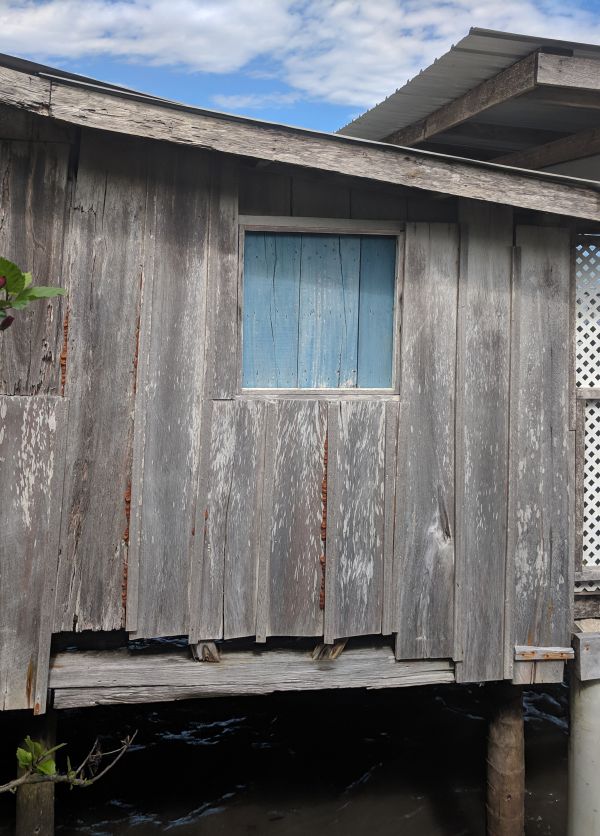
Here, your neighbor at the next bar stool is more likely to be a sun-weathered, beaten-down refugee escaping a former life up north than he is a Tommy Bahama-wearing, boat-shoed, cruise ship padder getting some solid-ground shore time between deck-chair-sized pina coladas.
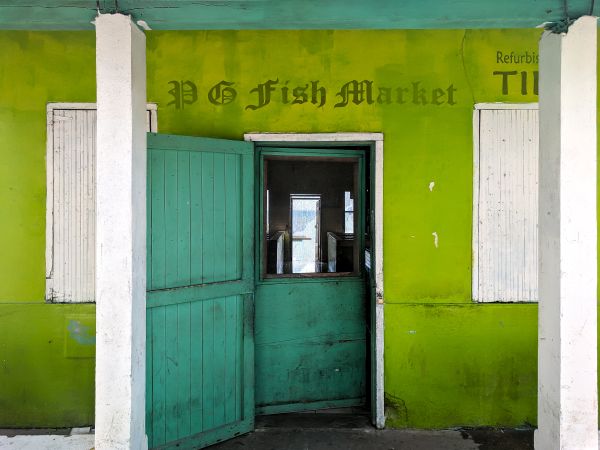
Although our personal escape from the north was planned and we weren't necessarily running from anything other than the doldrums of a more "normal" retiree life, we felt right at home.
We had a quick bite to eat at the cute and colloquial Asha's Culture Kitchen, looked around town a bit, failed to find a guide for the Temash river trip, and headed back to Sun Creek for the night.
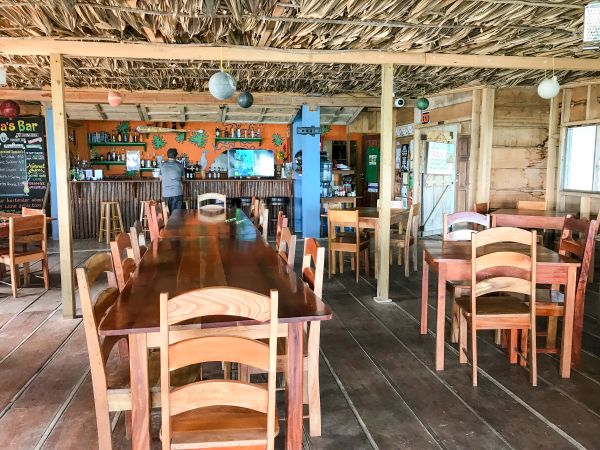
Now it was time to head back north towards Belmopan and eventually, Guatemala.
So far, Belize had been an incredible place to visit. With the lowest population density in all of Latin America (and one of the lowest in the world), and with numerous parks, reserves, and protected natural areas, Belize's emphasis on eco tourism was quickly becoming one of the unexpected delights of our trip.
In a country with barely more than 350,000 inhabitants, and with most of those living in the major cities or along the coast, vast tracts of undeveloped forest are left for the animals. And for us to explore!
Rio Blanco National Park
Our first stop after leaving our campsite at Sun Creek Lodge was the Rio Blanco National Park. Barely larger than one of the super-size palm fronds which grow in the forest, Rio Blanco National Park "preserves" a beautiful set of waterfalls along the river.
Of course, with people upstream who depend on the water for their daily life, the river wasn't the cleanest we had seen, but the waterfalls were very scenic.
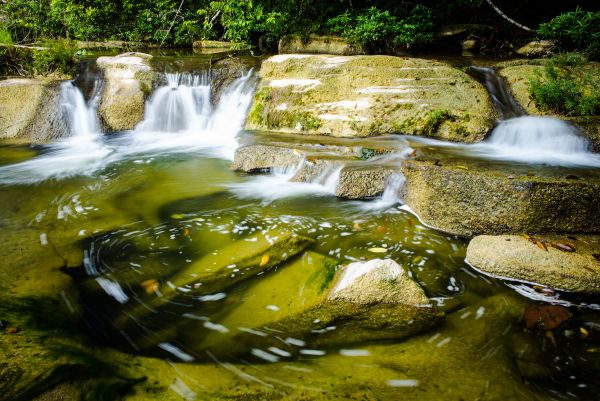
Up the Hummingbird Highway
I don't know who picks the names of the highways in Belize, but "Hummingbird" is certainly more creative than, say, "Mid-central Highway", or something similarly droll. Either way, after making our way back up the Southern Highway to Dangriga, we turned off from the coast and followed the Hummingbird Highway deep into the hills. With the Mayan Mountains beckoning on the horizon, we soon found ourselves curving through a glorious looking forest passing tumbling clearwater streams.
We had found a listing for a camp site through an entry in iOverlander, which promised it would be the "most interesting" camp we could imagine. I don't know if "interesting" describes it, but we were soon to find we had stumbled into a bit of an "off brochure" experience.
Sleeping Elephant Farm is owned by a British man, and becomes he only comes a few times a year, he leaves the place in the care of "Melito", a local of Mayan descent. After a bit of calling about, we succeeded in meeting up with Melito and his family outside a small village on the edge of a luxury eco-lodge estate.
The only access to the farm was through the gates of the estate, and after a long discussion/argument with the guard, our host was granted permission let us through. Although Melito dismissed this as a small inconvenience, I was beginning to wonder what we were signing up for. When Melito explained that we were only the second guests to stay there, and that the Sleeping Elephant Farm hadn't quite yet received an official designation for guest lodging (apparently a requirement of the government), my doubts only grew.
Setting aside our concerns, we loaded Melito and his small family into the truck, then followed a a muddy track through a tight little orange grove to a jungle clearing. Just beyond, a beautiful bend in the Sibun River shone in the afternoon light. Now THIS looked nice!

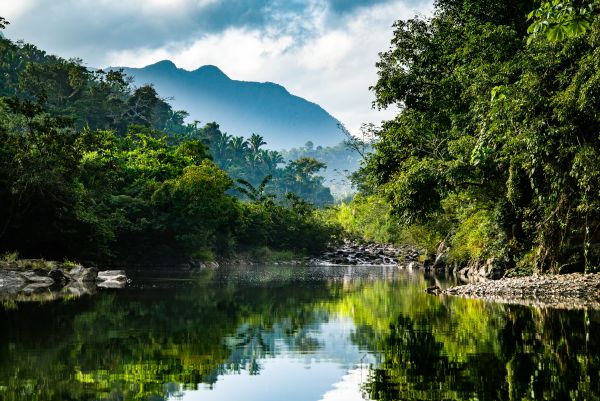
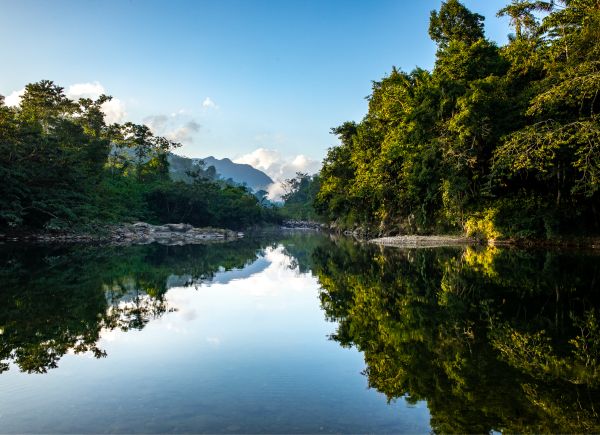
The Sibun River exits the Maya Mountains at this point, and upstream is all wilderness.
Melito explained that as a river and forest ranger, it was his job to look after not only the farm, but the entire sweep of wilderness beyond. It wasn't clear at this point whether the titles and duty were self-given, but it was clear Melito wanted us to know he wasn't just a "guide", but a "nature educator". Whatever. The site was beautiful, and official titles aside, we were happy to be in the hands of someone who passionately believed in what he was doing.
The next day Melito took us on a hike through the forest to see an ancient Mayan ceremonial cave hidden deep in the jungle. This required us to skirt through the edge of the eco-estate once more, Melito all the while muttering under his breath about the lodge owners, who "think they can just fence off the wilderness." Okay.
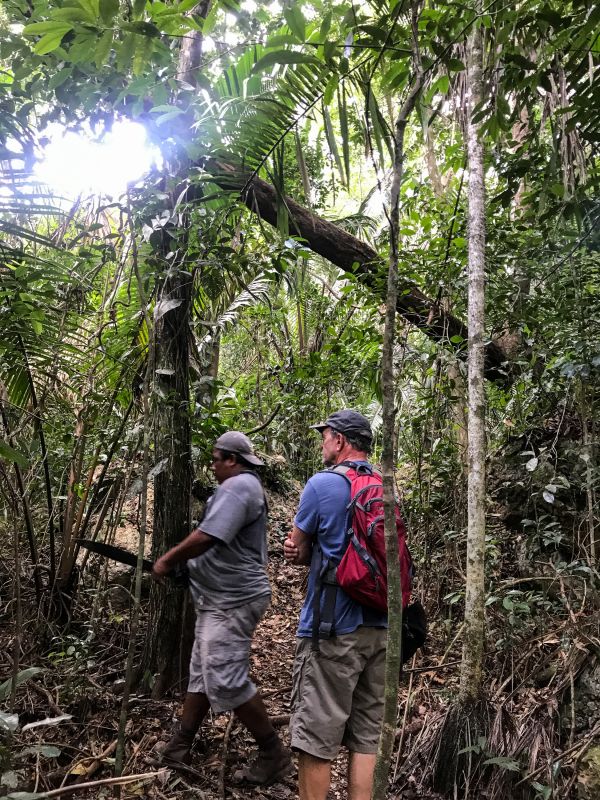
Our guide--oops, I mean nature educator--showed us all the various plants and explained their use, both in ancient and modern times.
We had a laugh when Melito said he would love to be on the TV show, "Survivor". He believed his intimate knowledge of the native plants would give him a serious advantage over the other contestants, who would soon be bug-bitten, emaciated shadows of their former selves, while he basked in comfort, perfectly at home in a hand-crafted, palm-frond lodge in the wild.
The trail led up a narrow ridge for a while, before dropping down into a dry river course.
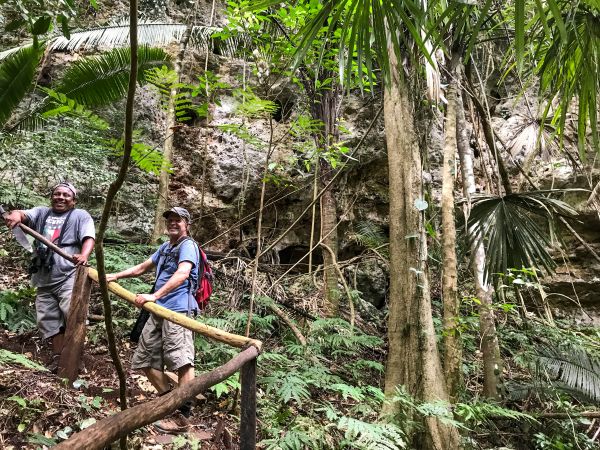
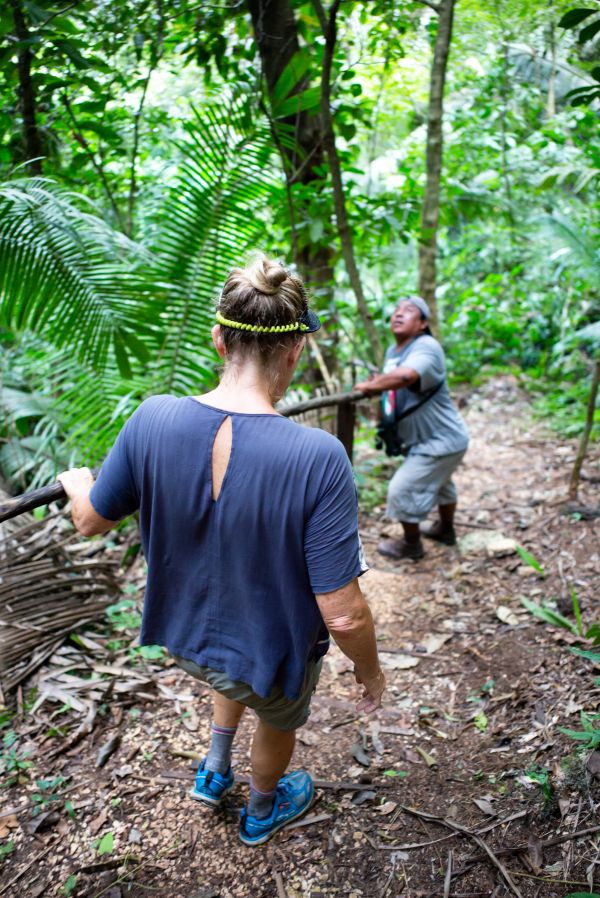
As we labored on the path, Melito told us how the ancient Mayans believed that the caves were one of the gateways into Xibalba, the Mayan mythological underworld.
Our trail soon ended at a limestone cliff, which was undercut by the entrance to a large cave. From a viewpoint just opposite the entrance, we could peer into the dark underbelly of the Mayan world.
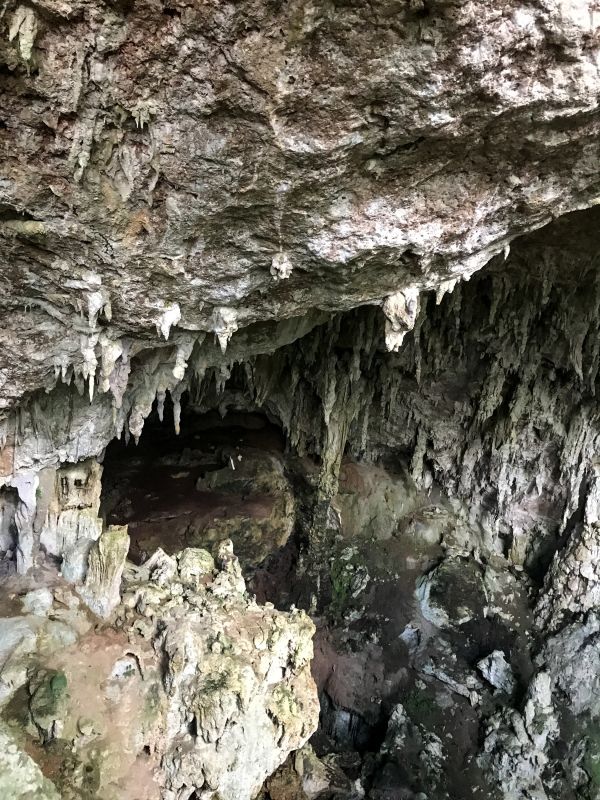
The face of the cave was literally dripping with stalactites and other calcified deposits, creating a fear-inspiring curtain of contorted shapes which hung from the limestone wall.
We could easily imagine how the cave could inspire Mayan superstitions, as it seemed as if we were staring into the mouth of a hideous beast. In that Mayan language, xibalba means "place of fright", an apt title indeed!
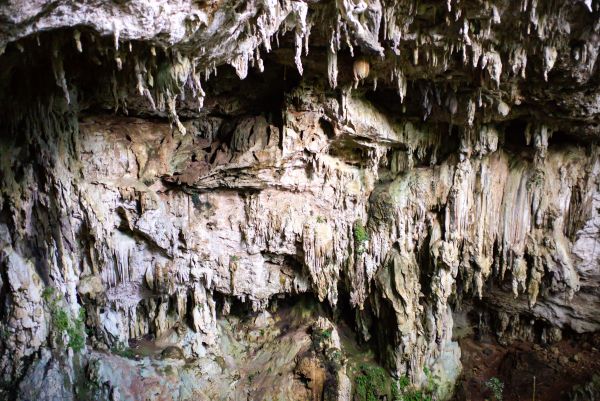
According to Melito, the ancient Mayans use the cave for religious ceremonies, often involving bloodletting and both animal and ritual human sacrifice. He claimed that deep inside are human bones which have become embedded into the limestone from years of calcification from the water dripping from the stalactites.
Melito told us that the Mayans believed that after being sacrificed in the cave, the "volunteer's" spirit would rise up through the stalactites, which connect to the roots of the sacred Ceiba tree growing above ground. The spirit would then follow the trunk up to the tree's branches into the sky, thus reaching the "divine upper realm" of the Mayan mythological world.
We made a brief foray into the tunnel, which Melito claimed extended more than 8 km down the ridgeline, but with only our cellphones to light the way, we couldn't go far. A few hundred feet in, we turned around and exited via a more conventional path--by foot. After leaving the underworld, we sat in silence at the entrance while Melito lit a smoky, pungent offering in homage to the gods.
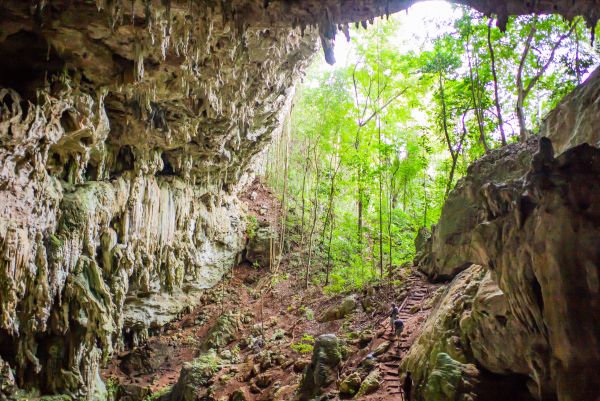
On the walk back we stopped here and there to photograph the forest. Thick and primeval, the jungle made us feel as if we were traversing a hidden and mysterious world. And to that point, I guess we were!
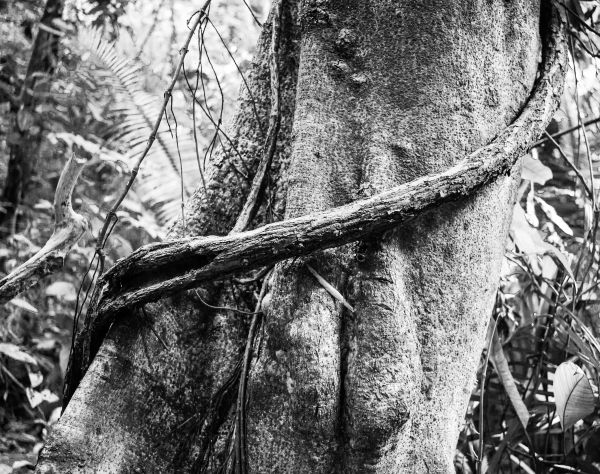
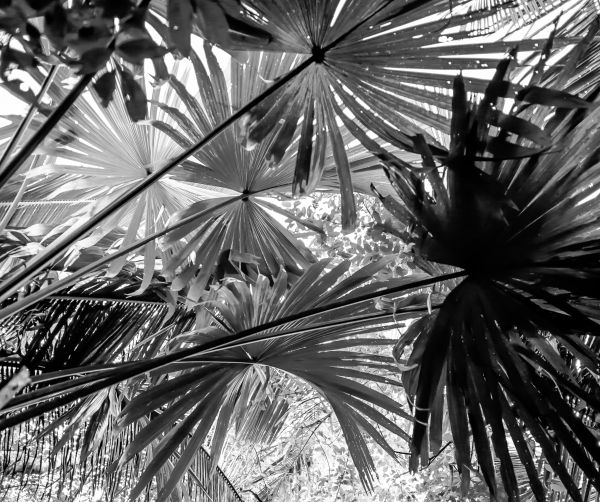
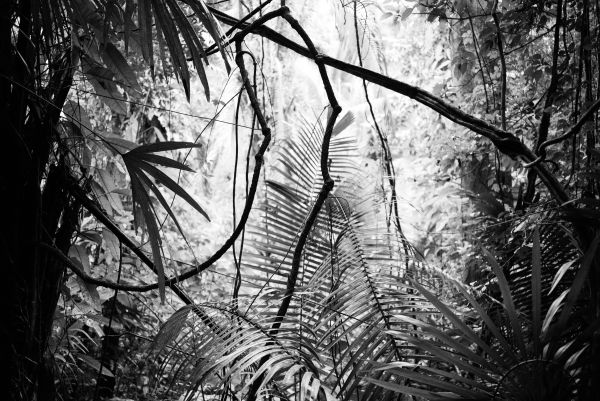
As wild and beautiful as the Sleeping Elephant Farm was, the temptation to stay for a few more days of exploring wasn't enough to scratch the itch we were feeling to get back on the road to Guatemala. Hopefully other travelers will seek out Melito in his little neck of the wilderness and enjoy a similar "off brochure" experience.
Belize Bird Rescue Center
From Sleeping Giant Farm we drove up to the capital city of Belmopan, the second largest settlement in Belize. With a whopping 16,000 or so inhabitants, we hoped we wouldn't get lost amid its streets and alleys, and we didn't.
Instead, we found a nice campsite at the Belize Bird Rescue Center.
Run by an Australian couple, Nikki Buxton and Jerry Larder, the Belize Bird Rescue Center's origin was something of an accident.
Nikki and Jerry had bought 25 or so acres on the Roaring River (which didn't roar while we were there), just outside Belmopan. Intending to use the place as a base for travel, their plans changed when someone brought them an injured parrot.
One hurt bird led to another, and another, and before long people from all over the country were bringing them injured, rescued, or unwanted birds.
Later they added a second sizable piece of land, and now have 50 acres of park-like grounds. Scattered about here and there are numerous cages for housing the birds, and flight aviaries for those recovered enough to fly. Auxiliary buildings, rental cabanas and a BnB round out the operation's infrastructure. They take campers like us, too.
Over the past 15 years Nikki and Jerry have planted numerous flowering shrubs and trees which attract many different varieties of wild birds, too. With 100 acres of dense forest adjoining the property, and with all their wild avian brothers for company, released birds seem reluctant to leave. Each evening and morning flocks of noisy parrots, toucans, passerines, and other native tropical species wheel about the sky, calling loudly to each other, or sit quietly (and sometimes not-so-quietly), perching in the trees.
When we arrived we were greeted by a friendly dog, and a funny-looking little bird called a chachalaca. "Chacha" the chachalaca didn't have any tail feathers, and perhaps that's why he seemed to prefer to walk instead of fly.
Unless he was chasing me down to peck sharply at my feet, that is. Every time I walked by he swooped down from some hidden perch, lit on the ground, then charged at me, wings spread and neck bent forward, heading sharp-beak-first for my toes.

Chacha seemed to favor Karen, though, and even let her lift him gently onto her arm and scratch the back of his neck. Eventually, Karen had to run "interference" for me so I could safely walk to the shower.
In spite of the pecking, we ended up staying four nights, often joining Nikki, Jerry and other guests for a shared dinner on the broad veranda overlooking the property.
(Update: we learned later that Nikki and Jerry had moved Chacha to one of their friends' properties, with the hope of habituating him back to the wild. I suspect he was becoming too much of a problem for other guests, and they figured he would be better off with less human contact.)
Mountain Pine Ridge
At this point we had been in Belize nearly three weeks and had covered the country top to bottom (several times over). There was one place left to go: the Mountain Pine Ridge area of western Belize.
We had been told about Mountain Pine Ridge from other travelers, who described it as very different from the "tropical" Belize we had been visiting. In the Pine Ridge area, dry forests covered the mountains, through which beautiful rivers flowed, interrupted here and there by wonderful cascades and waterfalls.
Of course, the rivers were nothing unique--unlike the Yucatan, which has no surface water, Belize is literally overflowing with rivers and waterfalls--and we had become accustomed to riverside campsites where we would have an opportunity for a cool-off swim. Still, we wanted to make sure we took every opportunity to experience Belize's many hidden wonders.
After a long bumpy ride into the hills south of San Ignacio, we camped at a beautiful spot called Pine Ridge Lodge. The owner was a friendly British ex-pat who had bought the business a few years earlier, and as it turns out, he had come from Guatemala, where he ran a high-end hair salon in Guatemala city for twenty years. There he had also been the personal hair dresser for the now-disgraced former president and first lady! We enjoyed hearing about how, on the president's appointment day, a bullet-proofed Suburban would show up and whisk him away to the presidential palace.
We both took advantage of his considerable skill to get a bit of a trim.

 Mountain Pine Ridge reserve is also the location of the Caracol Mayan archeological site. After some consideration we decided to skip the rough, two hour drive to the site. We still had a few more ruins to visit in Guatemala, and felt that for now we would save the wear and tear on the truck. Instead, we made a trip out to the river to see Big Rock Falls.
Mountain Pine Ridge reserve is also the location of the Caracol Mayan archeological site. After some consideration we decided to skip the rough, two hour drive to the site. We still had a few more ruins to visit in Guatemala, and felt that for now we would save the wear and tear on the truck. Instead, we made a trip out to the river to see Big Rock Falls.

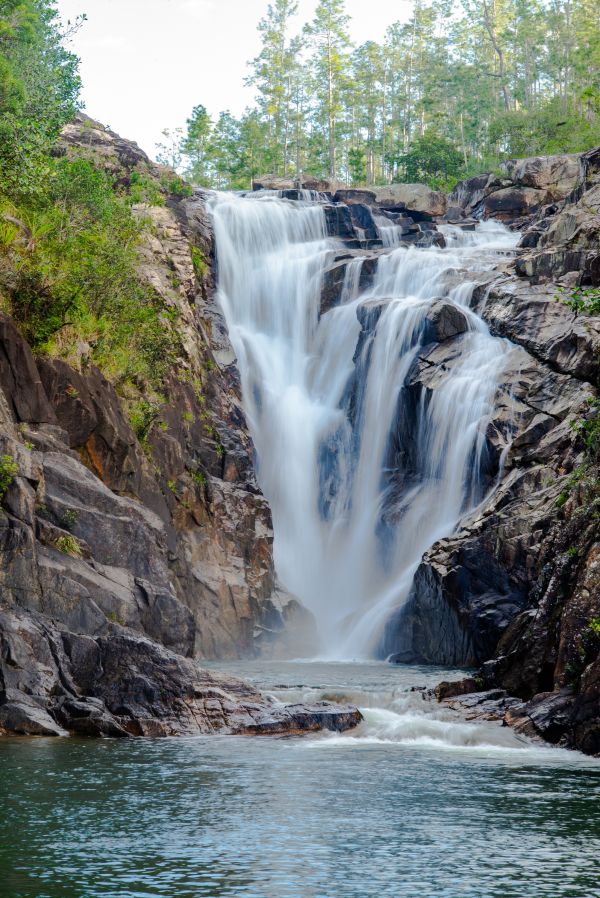
Below the cascade, the cool water of Privassion Creek pooled up, perfect for a cool-off swim.
On to Guatemala
From Pine Ridge Lodge we drove to San Ignacio to position ourselves for the border crossing into Guatemala. Just north of town we found a nice campsite at a restaurant at Clarissa Falls, where (again) we found a beautiful river flowing through the forest.

From end to end, Belize had been an unexpected delight. Many overlanders, eager to get on with their journeys or shy the budget to fully experience the country only give Belize a cursory visit. In our case, we didn't mind the extra expense, and chose to give Belize a more thorough explore.
With mist-draped mountains thick with jungles and forests, cool, clear rivers cascading to the sea, mysterious caves and well-preserved Mayan ruins, and sparkling sands and turquoise waters of the Caribbean coast and isle, Belize has more natural beauty packed into its tiny, 8800 square mile "footprint" than any nature lover could hope for.
Add in the diverse blend that makes up Belize's 370,000 inhabitants--the coastal Garifuna, indigenous Mayans, ladinos, Mennonites, descendants of European settlers, as well as ex-pats who are either "running from" something or "running to"--and you have a cultural mix unmatched by any country in Central America.
Though we were "strangers in a strange land", we felt completely at ease traveling through this amazing country and meeting its friendly people.
We wish we had more time to spend in Belize, but the rest of Central America beckoned.
It was time to heed its call.